If you are a fan of flea markets like I am, you might have stumbled across vintage glass or metal coffee pots. Percolators were present in just about any kitchen in the 19th and the better part of the 20th century until the invention of the automatic drip coffee maker pushed them out of the spotlight.
Even though the popularity of percolators has dramatically decreased, some brands still manufacture them up to this day. However, when you search for a percolator online, you come up with octagonal design Moka brewers, as well as stumpy silhouette coffee makers similar to those you saw in the antique fairs. So, are these coffee makers the same? Let’s take a closer look at Moka Pot vs. percolator battle and find out the answers!
Is Moka Pot and percolator the same thing?
There is a lot of confusion online regarding the percolator topic. You may have stumbled upon articles about percolators while referring to Moka Pots. So let’s define the percolation process first.
In simple terms, percolation is a chemical process of filtering a liquid through a porous substance and extracting a soluble component. A few coffee makers use percolation for coffee extraction, including siphon brewers, filter drip brewers, Vietnamese phins, and Moka Pots.
However, not every coffee maker can be called a percolator as that’s a patented invention with a unique mechanism inside it.
Now that we got the conceptual confusion out of the way let’s find out how these old-fashioned coffee makers work.
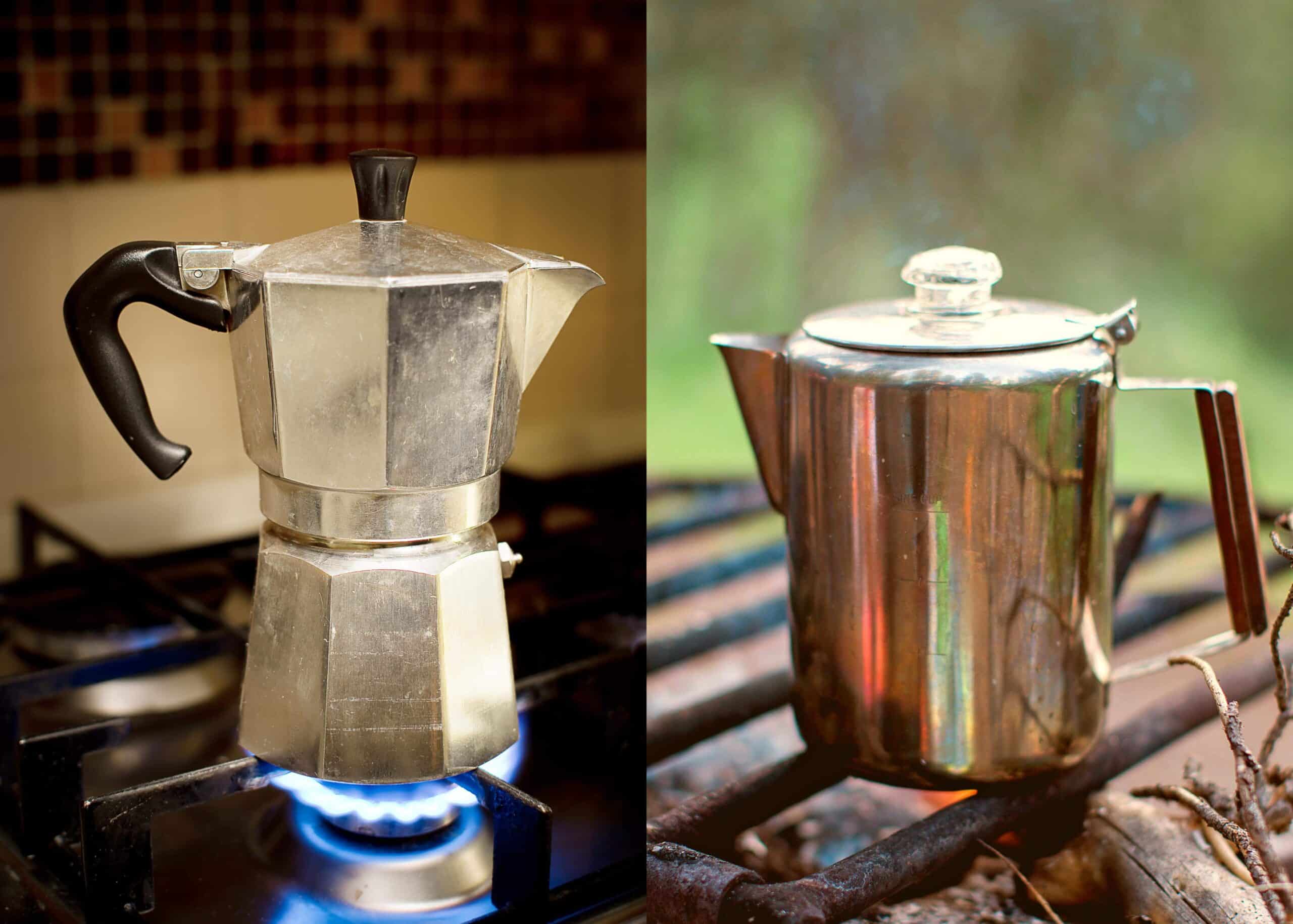
How does a Moka Pot work?
The Moka Pot was invented in 1933 in Italy by Alfonso Bialetti. The classic model is aluminum, but newer models also come in stainless steel.
The Moka Pot consists of:
- The bottom chamber for water
- A metal basket for coffee grounds
- The top chamber for brewed coffee
You pour water into the lower water chamber and coffee grounds into the little metal basket that sits on top of the water in the middle section of the coffee maker.
When you put the coffee pot on a stove burner (or any other heat source), and the water gets heated, the steam in the bottom chamber rises, increasing the pressure. It forces the water up through the coffee grounds. Finally, the brewed coffee ends up in the upper section of the coffee maker.
The brewing process is finished when all the water travels from the lower chamber to the upper, and you don’t hear the spluttering sound anymore.
A Moka Pot is commonly referred to as a stovetop espresso maker. While it does not make espresso with golden crema as it doesn’t reach the high pressure that espresso machines do, espresso-like coffee is a fair term. You can make concentrated coffee with it, and the serving size is similar to a serving of espresso.
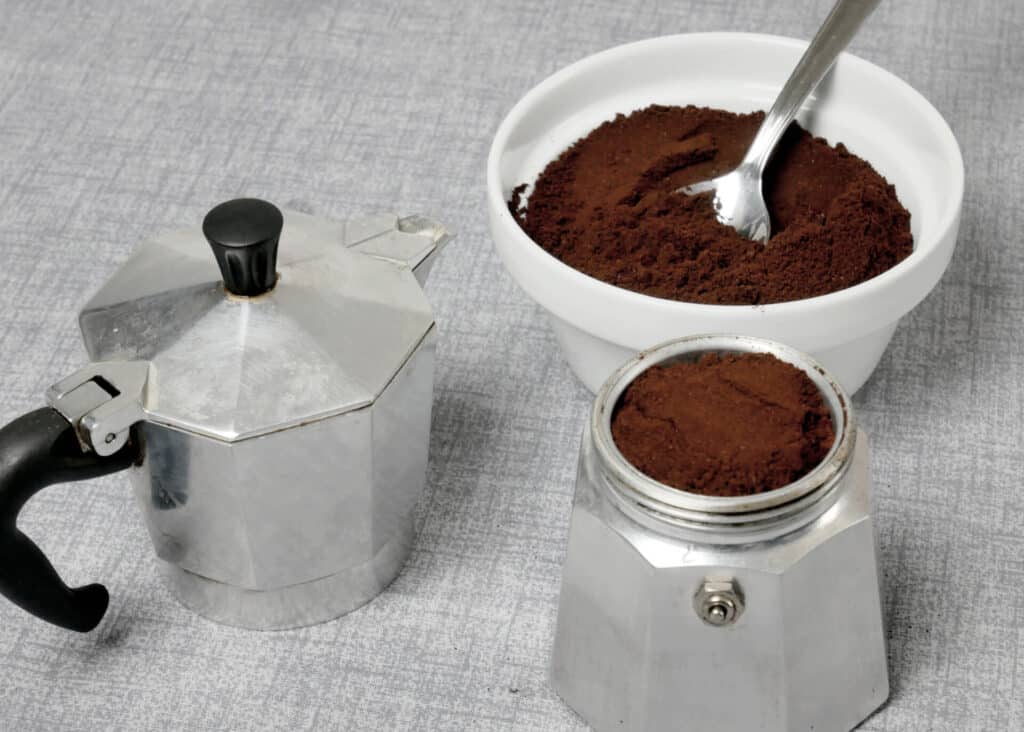
How does a percolator work?
The modern version of the percolator dates back to 1800. It was invented by an Illinois farmer Hanson Goodrich.
Even though it looks like a one-piece gadget externally, it has an inside mechanism that allows for brewing coffee.
The percolator consists of:
- Water vessel
- Tube
- Filter basket
- Water diffuser or spreader plate
Pour the water into the empty coffee pot to make coffee with the percolator. Next, insert the tube with the coffee basket, fill it with ground coffee (here is my list of the best coffee for a Moka Pot), and put the spreader plate on top. Then, cover the percolator with the lid and place it on the heat source.
When the bottom of the percolator is heated, the water starts boiling. Due to the pressure, the water bubbles head up the tube. However, what happens next is the major difference between the percolators and the Moka Pots.
When the boiling water rises up the tube and hits the top of the percolator, it falls onto the perforated spreader plate covering the basket with the coffee grounds. The water seeps through the coffee grounds and drips down into the vessel, right where it began. There is no separation between the fresh water and the brewed coffee, so the same coffee recirculates until you remove the coffee pot from the stove.
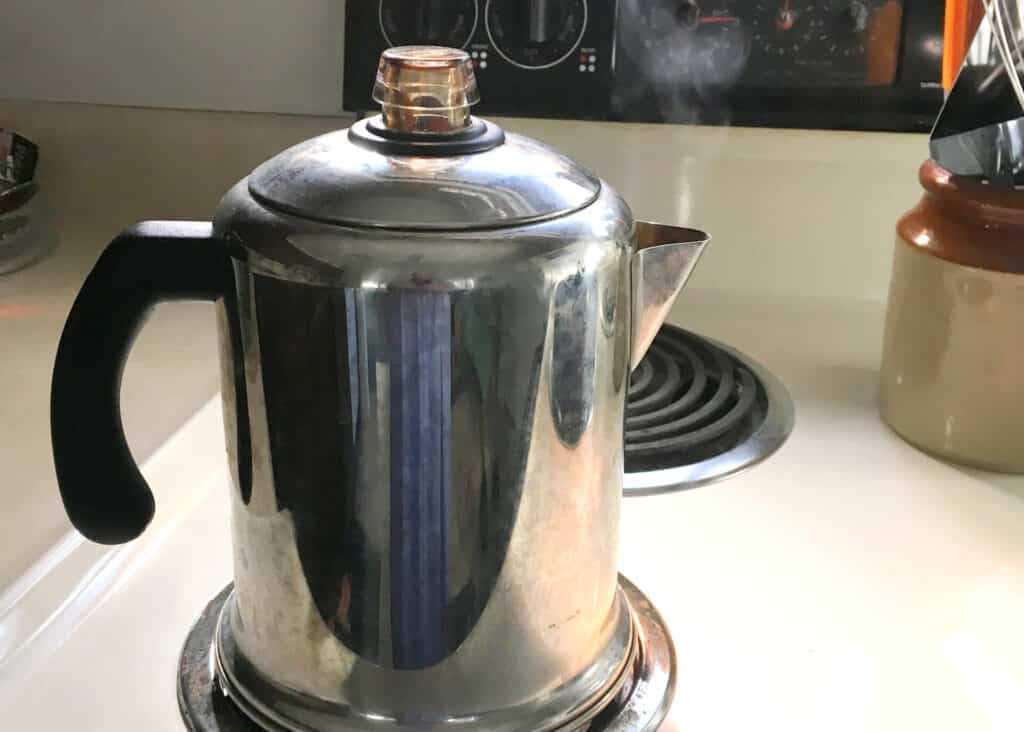
Moka Pot vs. percolator: which should you choose?
Moka Pots and percolators were designed to quickly and easily brew coffee. Back in the day, setting a coffee pot on a stovetop and letting it do its job while you cook breakfast was the ultimate idea, and both of these coffee makers did just that. Have you got your curiosity spiked and want to try brewing coffee using one of those nostalgia coffee makers? Moka Pot vs. percolator comparison will help you decide which one works better for you.
Ease of use
Moka Pots and percolators are low-tech gadgets. If your grand-grand parents could operate them, you will probably find the coffee brewing straightforward using either of those. You won’t have fancy timers telling you when the brewing process is complete. Instead, you’ll have to use your own eyes and ears!
Moka Pot
Using a Moka Pot is easy enough once you get the hang of it, but perfecting the extraction can take some time. Most Moka Pots are pretty small, and it can be awkward heating them on big stove burners. They are supposed to have heat-resistant handles, but that doesn’t always work out in practice. You might need a potholder to get the Moka Pot off the burner, and you’d better be careful to not set the potholder on fire!
It’s also possible for Moka Pots to overflow, especially if you fill it with more water than it’s supposed to have. Moka Pots have a line marking the water limit (located just below the pressure valve). Still, it can be hard to see this point clearly inside the small models.
The Moka Pot performs best with medium-fine coffee grounds that may not be readily available at your grocery store. You don’t want the very fine grind used for Turkish coffee, either. It will clog the pores of the metal coffee filter and won’t allow the water to seep through the coffee grounds. Therefore, having a burr coffee grinder or buying the coffee ground to the specified size from the specialty coffee store will help achieve the best results.
Percolator
Percolators were designed to brew a batch of coffee for a group of people or a family. The large size of a percolator, at least relative to a Moka Pot, makes it easier to load both water and coffee grounds without making a mess in your kitchen.
Percolators perform best with a coarser grind of coffee beans similar to the one used for the French press. Ground coffee from a supermarket can be used with it, even though you will not get the freshly ground coffee aroma you can achieve when grinding your own beans right before brewing.
Winner
Percolators are easier to wrangle because they are bigger, and you can use store-bought ground coffee with them.
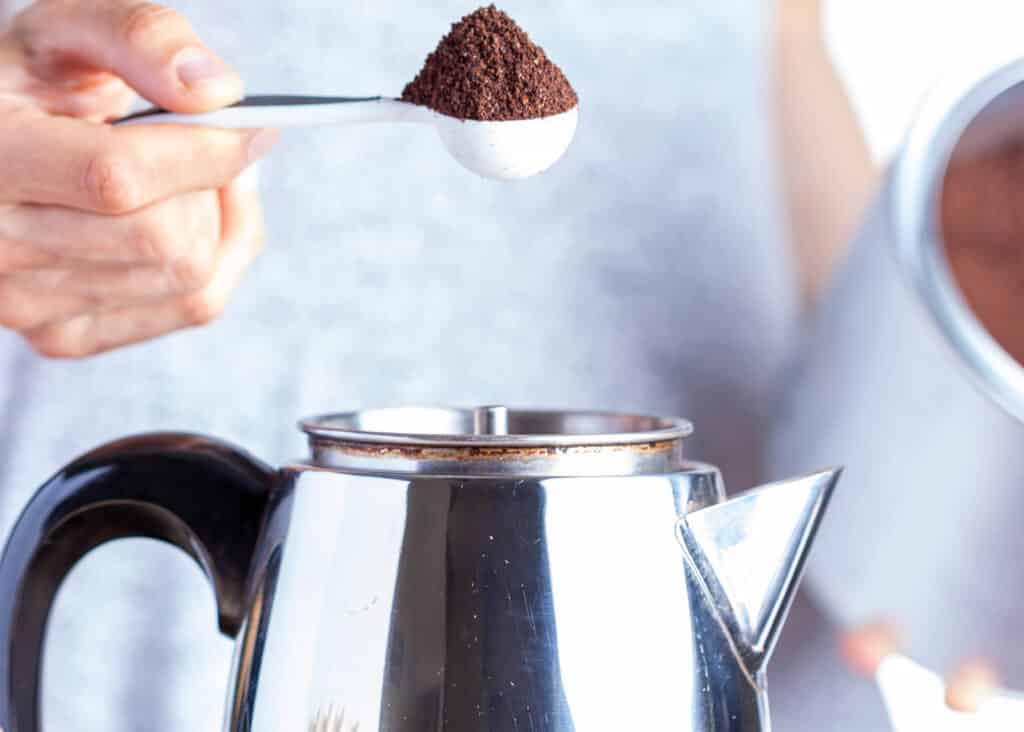
Brewing time
As you evaluate different brewing methods, a necessary consideration could be how long it takes to produce coffee. While speed may be of the essence if you have a tight morning routine, you might also be willing to wait a bit for better coffee.
Moka Pot
Some people prefer to heat water in a kettle before pouring it into the lower chamber of the Moka Pot to speed up the coffee extraction. Heating water before brewing improves the coffee’s taste and decreases the brewing time. However, you shouldn’t use boiling water as it will result in over-extraction and a bitter flavor. Around 158°F (70°C), water temperature is optimal.
Brewing Moka Pot coffee should take 5 to 10 minutes depending on the coffeemaker size and the heat intensity.
Bialetti Venus 4-Cup Induction Espresso Maker
Easily prepare rich and velvety espresso-like coffee on the stove. Brews up to 4 2-oz. cups of smooth and full-bodied coffee in less than 5 minutes. Features a contoured handle for a comfortable grip. The polished stainless steel build provides long-lasting durability and is suitable for all stove types including gas, electric, and induction.
Percolator
Brewing coffee with a percolator will take from 5 to 8 minutes. If you prefer a stronger cup of coffee, let it percolate a bit longer.
However, brewing for more than ten minutes should not be allowed. If the water boils too long, the coffee will over-extract and taste bitter, so you want to avoid that. Also, running the percolator too long can produce too much caffeine in your coffee.
Winner
Both coffee makers brew coffee reasonably quickly, although not as fast as capsule coffee machines like Keurig or Nespresso. Generally, a small size Moka Pot will brew faster than a large percolator.
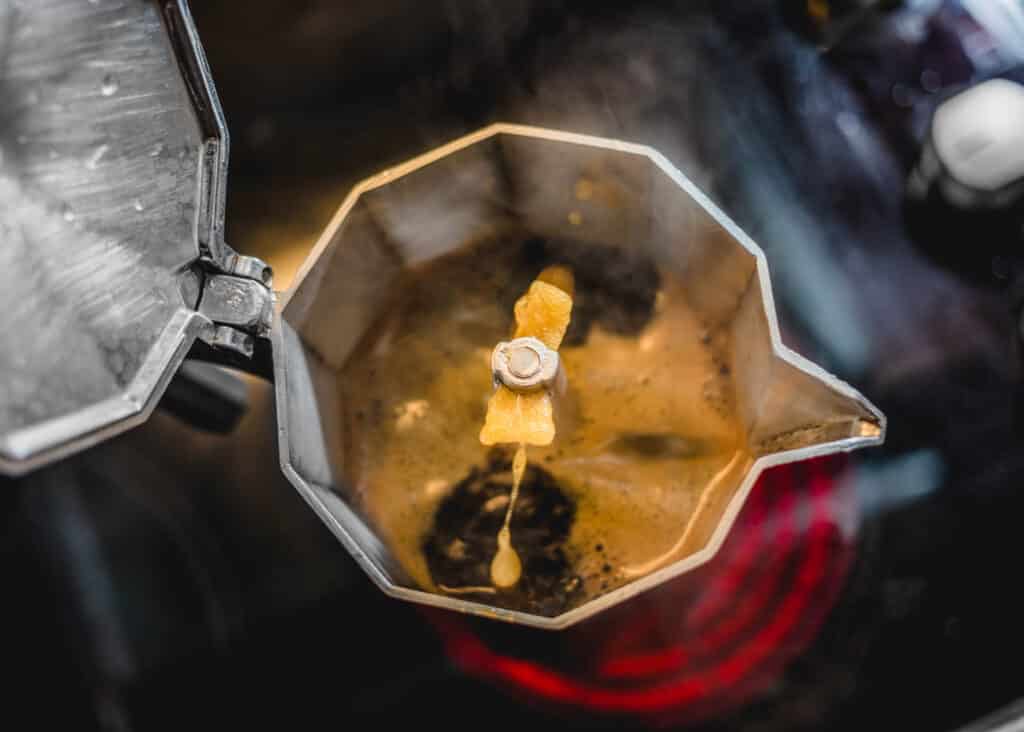
Capacity
Knowing how much coffee you regularly plan to make is important in deciding which coffee maker to buy. However, you may also have to be realistic about whether quantity or quality matters more to you.
Moka Pot
Moka Pots come in various sizes, but none are very big. While drip coffee makers are usually sized based on 5-ounce cups of coffee, Moka Pots use espresso serving sizes. Hence, a cup is only two ounces. The 12-cup Moka Pot, the largest size available, only makes 24 ounces of coffee.
While it is concentrated coffee, a Moka Pot won’t give you a bottomless mug for a long work session or a large batch of coffee to serve a big group of people.
Percolator
Percolators are made for the job of serving groups of people. They brew regular-strength coffee, so just like with the drip coffee makers, the serving size is a 5-ounce cup.
As with other coffee makers, there are a lot of 4-cup and 12-cup percolators on the market. However, they also come in huge sizes, like the 55-cup urn percolators you might find at a church or business conferences.
West Bend Electric Coffee Percolator
The classic 12-cup stainless steel percolator brings back the strong flavor and aroma of percolated coffee. Perfect for the person who loves the robust taste of percolated coffee but is easy enough for anyone to use. Features ready-to-serve indicator light and coffee level indicator. Keeps coffee at the perfect serving temperature.
If you are making coffee for one person, the hard part might be finding the right size percolator to suit your needs. However, if you drink a lot of coffee, the smallest model will do the job.
Winner
Coffee percolators can brew more coffee in one go than Moka Pots do, even though the coffee is more diluted.
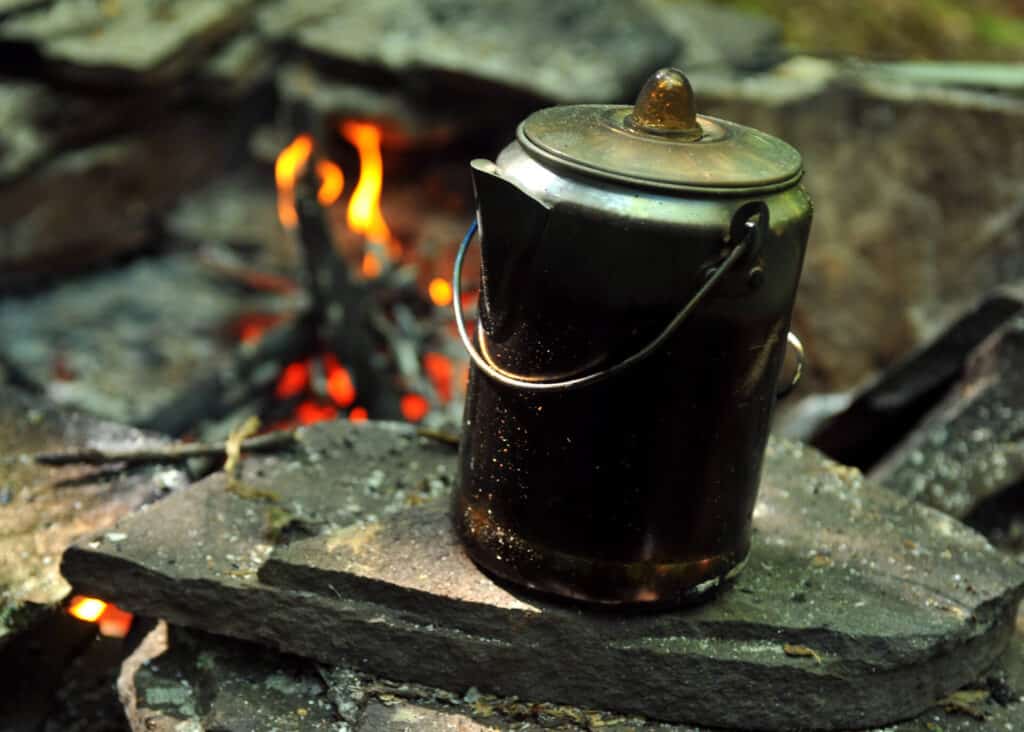
Taste
The whole point of pursuing a new coffee brewing method is to make delicious coffee. So as you deliberate over Moka Pot vs. percolator dilemma, you want to consider the taste of the coffee each brewing method produces.
Moka Pot
A Moka Pot is commonly called a stovetop espresso maker because it produces a strong coffee. But, more importantly, it’s also rich coffee that is full of flavor. This coffee maker does not require a paper filter, so its output has a bit of oil like French press coffee. However, a Moka Pot does not immerse the ground coffee in hot water while brewing. Therefore, the result is cleaner.
A significant advantage of Moka Pot coffee is what you can do with it beyond drinking it plain. You get concentrated coffee similar to an espresso shot, so you can make a cappuccino or a latte at home. When there is a lot of steamed milk in your coffee, you probably won’t notice that it does not contain a real espresso.
Moka Express is the original stovetop espresso maker that provides the experience of the real Italian way of preparing coffee. Its unique shape and the inimitable gentleman with mustache date back to 1933, when Alfonso Bialetti invented it. Available in many sizes and suitable for gas, electric, and induction stoves (with the Bialetti induction adapter plate).
Percolator
If you brew coffee at home, you probably know that boiling water is not what you should use to make a good-tasting cup. With the stovetop percolator, the water reaches boiling temperature before brewing coffee. So essentially, the coffee gets burnt as soon as it gets hit by boiling water.
On top of that, the percolator has another major flaw. There is no separation between the fresh water and the brewed coffee. As a result, the same coffee repeatedly circulates through the coffee grounds, resulting in over-extraction and bitter flavor.
Electrical percolators have a somewhat improved mechanism with a built-in thermostat that switches the device into warming mode when the water reaches boiling. Also, a light-up indicator will inform you that the coffee is ready. Due to these design improvements, coffee made with the electrical percolator does not taste as burnt. Yet, it does not have the aroma you’d expect from freshly brewed coffee.
Percolator makes regular-strength coffee similar to Americano. It will not work for making cappuccinos, and other espresso-based drinks as the coffee is not as concentrated. However, you can make a delicious mocha by mixing cocoa powder with your coffee grounds before brewing the coffee.
Winner
Moka Pots produce concentrated coffee that generally has more flavor than the over-extracted brew of a percolator.
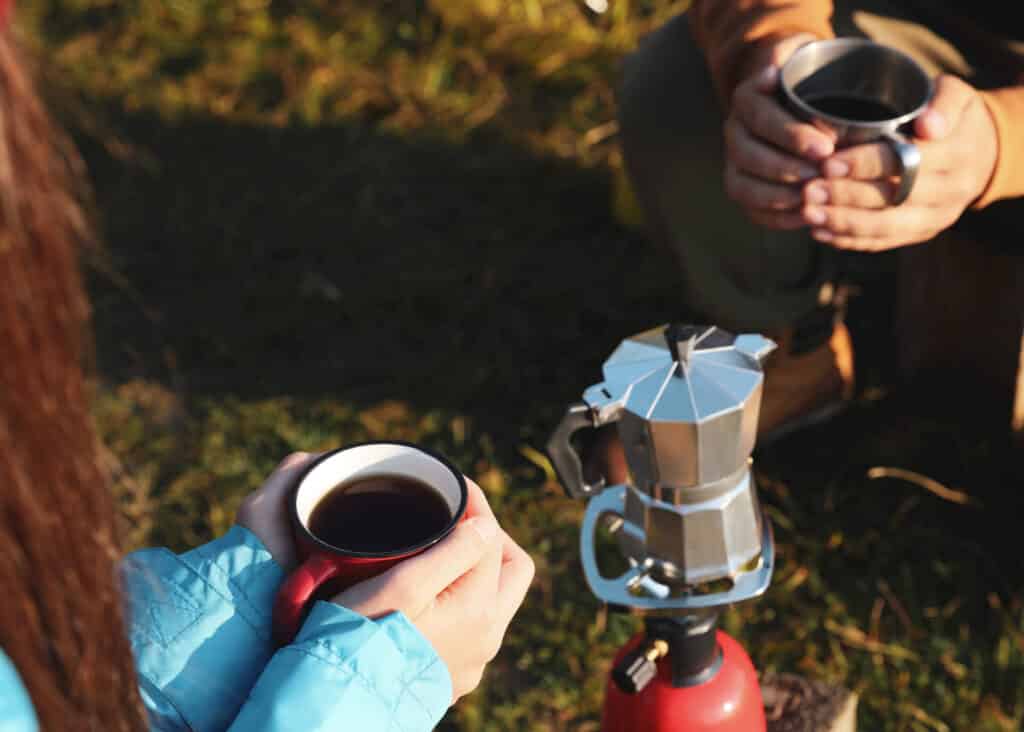
Cleaning
Cleaning is an often overlooked part of the coffee preparation process. As you consider Moka Pot vs. percolator, you need to ensure that your coffee pot’s maintenance fits well into your routine.
Moka Pot
Many Moka Pots, such as the classic Bialetti model, are made of aluminum and are not dishwasher safe, so all the components must be washed by hand in warm soapy water. However, if you get a stainless steel Moka Pot, depending on the model, you may be able to put it in the dishwasher, making its maintenance easier. Just follow the manufacturer’s instructions so you don’t accidentally ruin it.
Percolator
Most percolators sold these days are made of dishwasher-safe stainless steel. However, some vintage or lower-end models come in aluminum. If that’s the case, just like an aluminum Moka Pot, your percolator must be washed by hand in warm soapy water.
Winner
Whether you choose a Moka Pot or a percolator, always pay attention to its material and the manufacturer’s care instructions. Generally, percolators are easier to clean as they are bigger. You can often remove the lid and comfortably rinse them from the inside with a soapy sponge.
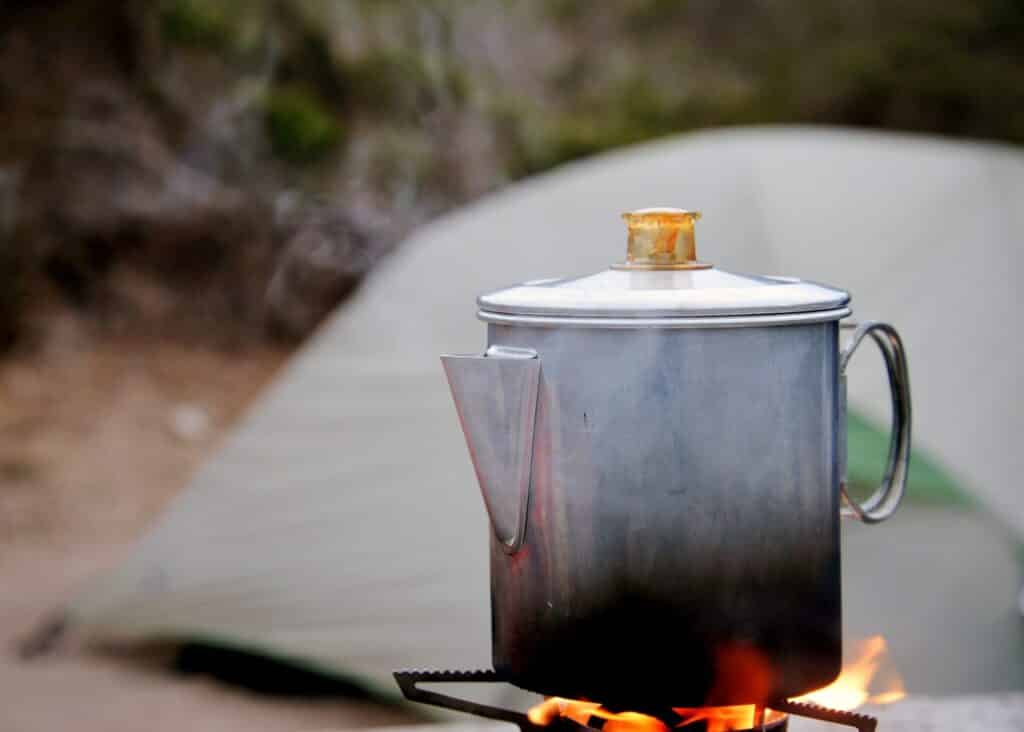
Cost
Whether deciding between Moka Pot vs. percolator or any other coffee maker, keeping your budget in mind is always a good idea. While neither of those coffee pots is as big an investment as buying an espresso machine, there are still some differences to consider.
Moka Pot
Bialetti Moka Pots start around $20 for the smallest size, and the price goes up accordingly with the size. You may also pay extra for dishwasher-safe stainless steel instead of the more common aluminum model.
Lesser-known brand coffee pots can be cheaper. So a Moka Pot is a great place to start if you are interested in experimenting with home espresso drinks but are not ready to splurge on an espresso machine.
Percolator
Budget aluminum percolators start at around $20, but the average price is $40. While they can get more expensive than Moka Pots, they are more likely to be made of durable stainless steel. Also, a percolator typically holds more coffee than a Moka Pot of comparable price.
Coletti Bozeman Camping Percolator
Essential camp kitchen equipment with hardwood handle, construction grade steel & heat-toughened glass top. This rugged camp coffee pot is engineered for the outdoors so you can take it anywhere.
Winner
Generic Moka Pots cost less than percolators, although sometimes you get what you pay for. So if you are after a value-for-money purchase, the original Moka Pot will be the best investment.
Though many similarities exist between the Moka Pot and percolator brewing methods, the former stands out in this competition. Although a percolator can come in handy on a group camping trip, a Moka Pot will produce better-tasting coffee that will satisfy a coffee lover any day.
Still unsure which coffee maker to choose? Check out my percolator vs. French press comparison to explore different options!




